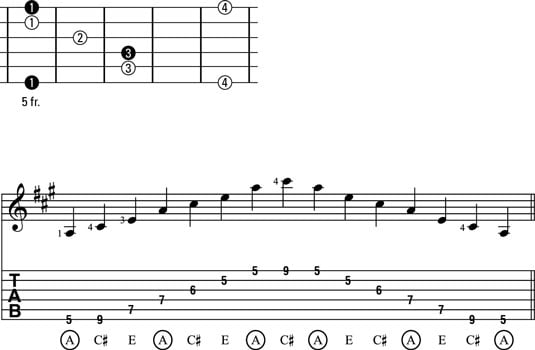After you memorize an arpeggio’s fingering pattern, simply move it up or down the neck to a different starting note to produce other major arpeggios. When you do this, the sound of the major chord stays the same. However, as you switch positions, the key, or letter name, of the arpeggio changes.
Preparing to practice major arpeggios
Playing major arpeggios prepares you for music with major chords — and, of course, for music that employs major arpeggios. With arpeggios you think in chords, but you play the notes separately. Bass players have to think in terms of chords and their individual notes. This exercise is good for guitarists, too, because you can play individual notes on the guitar (a melody thing) but use the chords of the song to tell you what notes to play (a chord and accompaniment thing).When you practice arpeggios, be sure to play them from low to high slowly, loudly, and deliberately at first to ensure you can play the notes cleanly. Then play them faster and lighter to produce the sound of arpeggios as they appear in real music. However, no matter how you play them, be sure to maintain your starting tempo and dynamic level (loudness) throughout each arpeggio.
Major arpeggio pattern #1
The figure below shows an A major arpeggio in 5th position in both a neck diagram and in music and tab format. Notice that the first note in the music staff has a fingering indication (the small 1 to the left of the note head). This tells you to use the 1st finger of your left hand to play that note.
Click here to download and print this arpeggio pattern.
Major arpeggio pattern #1 includes two out-of-position notes (notes that don’t fall within the four-fret span defined by the position and that require stretches by the 1st or 4th finger to play). They occur on the 6th and 1st strings. To play these notes, stretch your 4th finger up (toward the bridge) to play the note that occurs one fret higher than the one you would normally play.
Stretching between your 1st and 4th finger is a good physical exercise because it includes (and therefore expands) the in-between fingers. To help loosen your left hand, try playing just the first two notes of the arpeggio back and forth eight times slowly before you play the entire pattern.
The following figure provides an exercise in rhythm using major arpeggio pattern #1. This pattern is in the key of F major in 1st position in ascending and descending eighth notes. Because it doesn’t take many notes to complete the pattern, you go through it twice. The pattern in this figure occurs in the lowest position, where the frets are widest, so you can use it as a good stretching exercise, too.

